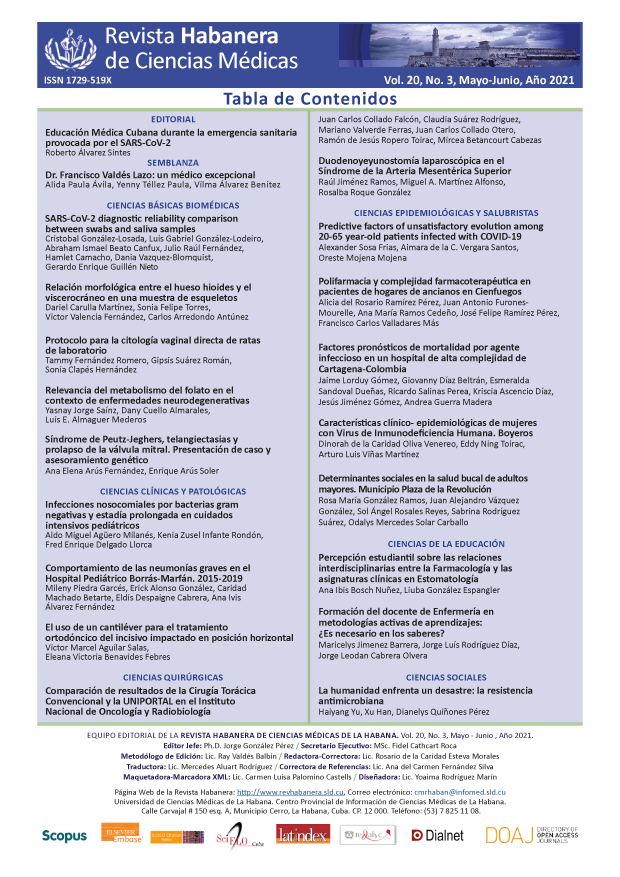Síndrome de Peutz-Jeghers, telangiectasias y prolapso de la válvula mitral. Presentación de caso y asesoramiento genético
Palabras clave:
síndrome de Peutz-Jeghers, asesoramiento genético, telangiectasia, prolapso de la válvula mitral, pólipos, epistaxis.Resumen
Introducción: El síndrome de Peutz-Jeghers se caracteriza por hiperpigmentación mucocutánea y hamartomas gastrointestinales que pueden aparecer desde el estómago hasta el ano. Tiene un patrón de herencia autosómico dominante y expresividad variable. El diagnóstico se basa en los hallazgos clínicos y la apariencia histológica de los pólipos. No ha sido reportado hasta ahora asociación de esta entidad a telangiectasias y prolapso de la válvula mitral.
Objetivo: Describir los hallazgos que permitieron establecer el diagnóstico de Síndrome de Peutz-Jeghers en un paciente y brindar asesoramiento genético.
Presentación del caso: Paciente masculino de 36 años de edad con antecedentes de prolapso de la válvula mitral que acude a consulta de genética clínica con su esposa para solicitar asesoramiento genético, debido a que tienen una hija con diagnóstico de Síndrome de Peutz-Jeghers y desean conocer el riesgo de tener otro hijo afectado. Al examen físico se observa mácula hiperpigmentada en labio inferior y varias de estas en encías. Con tales hallazgos y el antecedente de tener la hija Síndrome de Peutz-Jeghers se emite el mismo diagnóstico en el padre. Como dato de interés se constatan en este individuo múltiples telangiectasias en tórax, cuello y espalda. Los estudios realizados en busca de la causa de estas fueron negativos.
Conclusiones: Los antecedentes y los hallazgos encontrados en el paciente permitieron realizar el diagnóstico de Peutz-Jeghers y brindar asesoramiento genético. Se presenta el primer reporte de esta enfermedad asociada a telangiectasias y prolapso de la válvula mitral en la literatura científica.
Descargas
Citas
1.Jelsig AM, Qvist N, Brusgaard K, Nielsen CB, Hansen TP, Ousager LB. Hamartomatous polyposis syndromes: A review. Orphanet J Raro Dis [Internet]. 2014 [Citado 18/09/2020];9(101):[Aprox. 2 p.]. Disponible en: https://www.ncbi.nlm.nih.gov/pmc/articles/PMC4112971/
2. Rodríguez FA, Sorlí JV, Romero IM, Codoñer P. Registro y seguimiento clínico de pacientes con síndrome de Peutz Jeghers en Valencia. Rev Gastroenterol (Méx). 2020; 85 (2): 123-39.
3. McGarrity TJ, Amos CI, Baker MJ. Peutz-Jeghers Syndrome. In: Adam MP, Ardinger HH, Pagon RA, Wallace SE, Bean LJH, Mirzaa G, et al, eds. GeneReviews® [Internet]. Seattle (WA): University of Washington; 2021. [Citado 18/09/2020]. Disponible en: https://pubmed.ncbi.nlm.nih.gov/20301443/
4. Latchford A, Cohen S, Auth M, Scaillon M, Viala J, Daniels R, et al. Manage¬ment of Peutz-Jeghers Syndrome in Children and Adolescents: A Position Paper From the ESPGHAN Polyposis Working Group. J Pediatr Gastroenterol Nutr. 2019; 68 (3): 442-52.
5. Meserve E, Nucci M. Peutz-Jeghers Syndrome Pathobiology, Pathologic Manifestations, and Suggestions for Recommending Genetic Testing in Pathology Reports. Surg Pathol Clin. 2016; 9: 243-68.
6. Monica M, Auerkari E. Molecular Genetics of Peutz-Jegher Syndrome. Adv Heal Sci Res. 2018; 4: 142-59.
7. Chen HM, Fang JY. Genetics of the hamartomatous poly-posis syndromes: A molecular review. Int J Colorectal Dis. 2009; 24: 865-74.
8. Achatz MI, Porter C, Brugieres L, Druker H, Frebourg T, Foulkes WD, et al. Cancer Screening Recommendations and Clinical Management of Inherited Gastrointestinal Cancer Syndromes in Childhood. Clin Cancer Res. 2017; 23 (13): e107–e14.
9. Syngal S, Brand RE, Church JM, Giardiello FM, Hampel HL, Burt RW. Clinical Guideline: Genetic Testing and Management of Hereditary Gastrointestinal Cancer Syndromes. Am J Gastroenterol. 2015; 110: 223-62.
10. Orso PR, Tadeu B, Machado LE, Tokarski M. A Case of benign hereditary telangiectasia without family history. An Bras Dermatol. 2017; 92 (1): 162-3.
11. Schieving JH, Schoenaker MHD, Weemaes CM, van Deuren M, van der Flier M, Seyger MM, et al. Telangiectasias: small lesions referring to serious disorders. Eur J Paediatr Neurol. 2017; 21 (6): 807-15.
12. McDonald J, Pyeritz RE. Hereditary Hemorrhagic Telangiectasia. In: Adam MP, Ardinger HH, Pagon RA, Wallace SE, Bean LJH, Mirzaa G, et al, eds. GeneReviews® [Internet]. Seattle (WA): University of Washington; 2021. [Citado 18/09/2020]. Disponible en: https://pubmed.ncbi.nlm.nih.gov/20301525/
13. Andrabi S, Bekheirnia MR, Robbins Furman P, Lewis RA, Prior TW, Potocki L. SMAD4mutation segregating in a family with juvenile polyposis, aortopathy, and mitral valve dysfunction. 2011. Am J Med Genet . 2011; 155: 1165-69.
14. Benítez J, Núria Malats A, Osorio A, Robledo M, Rodríguez S. Glosario de Genética-Probando o caso índice [Internet]. España: Fundación Instituto Roche; 2020 [Citado 18/09/2020]. Disponible en: https://www.institutoroche.es/recursos/glosario/probando
15. Stratakis CA, Raygada M. Carney Complex. In: Adam MP, Ardinger HH, Pagon RA, Wallace SE, Bean LJH, Mirzaa G, et al, eds. GeneReviews® [Internet]. Seattle (WA): University of Washington; 2021. [Citado 18/09/2020]. Disponible en: https://pubmed.ncbi.nlm.nih.gov/20301463/
16. Carcavilla A, Santomé J, Pinto I, Sánchez Pozo J, Guillén Navaro E, Martín Frías M, et al. Síndrome LEOPARD: una variante del síndrome de Noonan con fuerte asociación a miocardiopatía hipertrófica. Rev Esp Cardiol. 2013; 66 (5): 350-56.
17. Goldman M, Bennett RG. Treatment of telangiectasia: A review. J Am Acad Dermatol. 1987; 17 (2): 167-82.
18. Payne SC, Feldstein D, Anne S, Tunkel DE. Hypertension and Epistaxis: Why Is There Limited Guidance in the Nosebleed Clinical Practice Guidelines?. Otolaryngol Head Neck Surg. 2020; 162 (1): 33-4.
19. Haidle JL, Howe JR. Juvenile Polyposis Syndrome. In: Adam MP, Ardinger HH, Pagon RA, Wallace SE, Bean LJH, Mirzaa G, et al, eds. GeneReviews® [Internet]. Seattle (WA): University of Washington; 2021. [Citado 18/09/2020]. Disponible en: https://pubmed.ncbi.nlm.nih.gov/20301642/
20. Sweet K, Willis J, Zhou XP, Gallione C, Sawada T, Alhopuro P, et al. Molecular Classification of Patients With Unexplained Hamartomatous and Hyperplastic Polyposis. JAMA. 2005; 294 (19): 2465-73.
21. Hui L, Nianshuang L, Huan H, Ying Y, Shashank S, Lingyu L, et al. AMPK Inhibits the Stimulatory Effects of TGF-β on Smad2/3 Activity, Cell Migration, and Epithelial-to-Mesenchymal Transition. Mol Pharmacol. 2015; 88 (6): 1062-71.
22. Nian Shuang L, Jun Rong Z, Hui L, Rong K, Xiao Ling H, Lu X, et al. LKB1/AMPK inhibits TGF-β1 production and the TGF-β signaling pathway in breast cancer cells. Tumour Biol. 2016; 37 (6): 8249-58.



